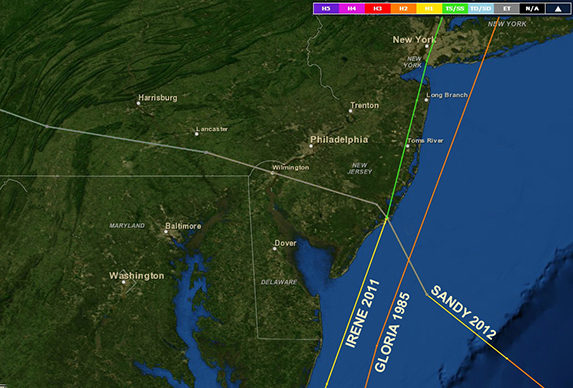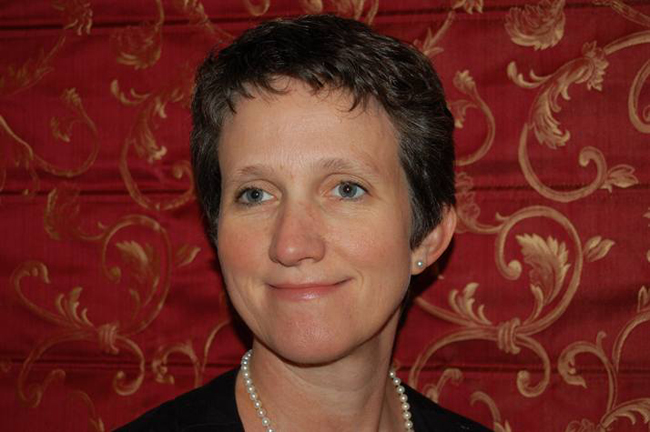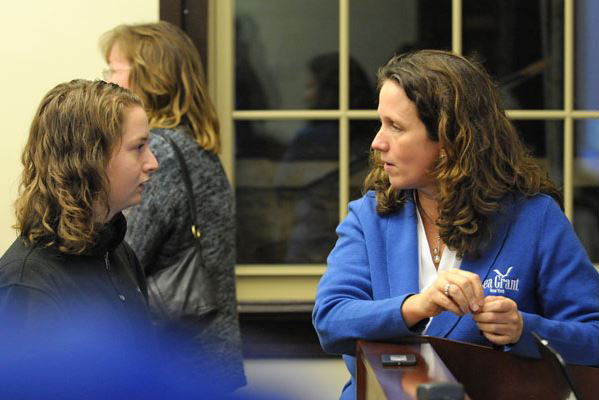Sea Grant Great Lakes Social Science Network assess the National Weather Service's system
Washington, D.C., September 11, 2014 - When it comes to severe weather, do you know the difference between a warning and a watch? Which one is worse? Which requires action? If you don’t know, don’t worry, you aren’t the only one.
The National Oceanic and Atmospheric Administration (NOAA)’s National Weather Service (NWS) uses terms like “watch” and “warning” to notify the public of potential severe weather and levels of danger. While these terms have specific definitions for scientists and weather forecasters, it is not always clear to affected communities what these phrases mean and what impacts they should expect.
To help address this uncertainty and to build a Weather-Ready Nation, the NWS is overhauling their hazard warning systems to make their communication more clear and insure that the public has a better understanding of what to expect from approaching storms. By using standardized language that describes potential results, rather than scientific words, people in affected areas receive relatable messages that paint a clear picture.
“Understanding how to best communicate about severe weather is imperative," says New York Sea Grant Associate Director Dr. Kathy Bunting-Howarth,
a member of a Sea Grant research team selected by the NWS to be a part of the Weather-Ready Nation project. Bunting-Howarth and others from the Great Lakes Social Science Network
helped to assess the Impact-based Warning System because of Sea Grant's
strong reputation for engaging local, sometimes hard to reach,
communities.
"We hope to take the lessons learned
from this project as well as the research results being conducted under
the Coastal Storms Awareness Program and assist our NOAA partners and
communities be better prepared for the next severe weather event," says Bunting-Howarth.

The National Weather Service’s "Weather-Ready Nation"
initiative was begun to help communities throughout the country better
prepare for and respond to severe weather events, such as Superstorm
Sandy, Tropical Storm Irene and Hurricane Gloria. Much of that
preparedness has to do with increasing the speed, accuracy, and
effectiveness of weather monitoring and warning mechanisms on the local
level. And finding the strongest ways to communicate weather messages to
residents is key. Photo: NOAA
The Sea Grant team conducted extensive research into the most effective
impact-based warnings through interviews, focus groups, and surveys. Their April 2013 report, “Evaluation of the National Weather Service Impact-based Warning Tool” (pdf),
allowed the NWS to improve the effectiveness of hazard communication to
the public. It offers a sort of mid-term evaluation of the
system’s effectiveness and stakeholders’ perceptions of it, while also
providing recommendations for further training and implementation
improvements. After being presented earlier this
year at the Social Coast Forum in Charleston, SC, the report sparked the interest of a number of
other groups and agencies that might expand on the study with further research.
The impact-based warning system, first piloted by the NWS in 2012
in five select offices, was expanded to the agency's 38
U.S. central region offices following release of the Sea Grant report. This new system—which offers emergency managers a tool to
communicate warnings to the general public by selecting specific phrases
to insure people across the country understand severe storm warning
systems—is currently being tested in additional locales throughout the country.
"The impact-based warnings are a great example of how small changes can improve the reception of communication strategies," says Katie Williams,
the University of Wisconsin Sea Grant funded graduate student on the
project. "Through social science research, the National Weather Service
was able to glean how different stakeholder groups were using the
warnings, so they could identify how to improve them. The NWS found more
warnings would not necessarily improve emergency response, but
emphasizing how people and property would be affected would."
Including Bunting-Howarth and Williams, this research was a team effort between representatives from five Great Lakes Sea Grant programs. Others included: Caitie McCoy and Leslie Dorworth (Illinois-Indiana Sea Grant), Dr. Jane Harrison (Wisconsin Sea Grant), Hilarie Sorensen (Minnesota Sea Grant) and Dr. Chris Ellis
(NOAA Coastal Services Center).
— Kathryn MacDonald, National Sea Grant College Program Office; Paul C. Focazio, New York Sea Grant
Spotlight on New York Sea Grant’s Associate Director: Kathy Bunting-Howarth, J.D. Ph.D.
New York Sea Grant Associate Director

Kathy Bunting-Howarth is the Associate Director for New York Sea Grant and an Assistant Director for Cornell Cooperative Extension. There she leads ten talented Extension Associates located in five offices along the many diverse coastal areas of New York State. She serves on the Faculty Steering Committees for the New York Water Resource Institutes and the Cornell Biological Field Station as well as an Ex Officio member of the Great Lakes Basin Advisory Council. Most recently, she was appointed to the Chesapeake Bay Program Science and Technical Advisory Committee as New York’s alternate. She provides national leadership in Sea Grant as the liaison of the Assembly of Sea Grant Program Leader’s to the Extension Disaster Education Network. Although Kathy has a strong background in water quality and watershed management, she also has interests in coastal policy and integrating the use of social science Sea Grant research and extension efforts.
Bunting-Howarth’s earned her doctorate in Marine Policy from the University of Delaware’s Graduate College of Marine Studies and holds a J.D. with a Certificate in Environmental and Natural Resource Law from the University of Oregon School of Law. Her undergraduate training was in Biology and International Relations.
You worked on the Impact Based Warning Assessment, what is your impression of Impact Based Warning?
Having recently experienced Hurricane Sandy and so many unnecessary deaths associated with that storm, I was impressed that the National Weather Service had developed a tool designed to provide the information that their stakeholders requested be involved.
What is something cool you learned while working on the Impact Based Warning Assessment?
I learned about straight line winds and microbursts while conducting the research. A month later, a micro-burst came through my yard and took down a favorite oak tree. I wish I had only learned about it while conducting research.

Kathy Bunting-Howarth (at right). Photo: Jim Russell, New York Sea Grant
Why do you think it is important to have social scientists at Sea Grant?
Sea Grant provides the science-based information to the people and communities that we serve. We need social science in order to complete our mission whether it be associating costs and benefits with a certain activity or learning about the values, beliefs and opinions of our stakeholders. This information helps us improve the types of information we provide and utilize the best methods of communication for our constituents in order to best assist them in decision-making.
What drove you to be a social scientist?
I realized in college that I would be happiest working around people. Already being a fan of marine and coastal science, the social sciences seemed a good fit. Although I started out law school thinking that I wanted to practice, I soon learned that I was more interested in understanding how the public influences policy and legislation. Thus, I went on to get my PhD in Marine Science (Policy) and conducted research using social science methods and embracing theories from political science, risk communication and anthropology.
How did you get involved with Sea Grant? When did you join Sea Grant?
My first interaction with Sea Grant was when I joined a team, which included a Marine Advisory Service agent, who was designing and implementing a watershed-based process for bringing together diverse stakeholders for the purpose of having them make recommendations to the State environmental agency on how to achieve improved water quality. That experience helped me begin my career with the State agency, which lasted almost 10 years. I’ve been with NYSG for over three years, now. I like being in a position to help fund the science needed by the resources management community and effectively bring that science to our stakeholders on both the marine and Great Lakes shores.
What is your favorite part about being a Sea Grant Extension agent?
I wish I was one. As Associate Director, I lead our team extension professionals. I do have some time for programming and I try to make it count—as with the IBW project. I love people and helping to solve problems whether I do that through facilitating discussions of wicked problems or by assisting with social science research.
What is the biggest challenge you face at your job?
New York is a big, diverse State so keeping abreast of issues in both the Marine and Great Lakes areas can be challenging and stimulating.
When did you know you wanted to pursue a career in science?
It was sometime in my younger years when I would mix random household items (baby power, toothpaste, sore throat spray, etc.) in a blue glass chicken and let it sit, thinking that I was discovering the cure to cancer, dream of being “Quincy” (the TV show from the late 70s, early 80s about the pathologist), and conducting middle school science fair projects on water quality. When I was in college, I realized that I was best suited for science which involved people—I double majored in Biology and International Relations.
What part of your job did you least expect to be doing?
I was pleasantly surprised by the extent of collaboration among Sea Grant programs. The network meetings and joint projects present great opportunities to interact with colleagues across the country and exchange lessons learned.
What’s at the top of your recommended reading list for someone wanting to explore a career in science?
In fourth grade, I read “Shark Lady” by Dr. Eugenie Clark and was inspired to pursue work in ocean and coastal issues. It really depends on what areas of interest that someone would have—would they like a book about the dangers of science and politics, an example of how social science can complement natural sciences to address an issue or a book challenging our romantic notion of nature and the need to restore it to its pristine condition.
And how about a personal favorite book?
During a recent walk to work, my husband and I discussed this very question as it is a one famous for being asked of nominees for President. I really can say that I do not have one favorite. If I must answer, it will be when I am a candidate for the office.
Do you have an outside hobby?
Our boys are young and so my hobbies tend to include the family: hiking in the parks around Ithaca, swimming, backyard grilling and playing games that my boys create themselves.
What surprised you most about working at Sea Grant?
I was not really surprised by this but it seems a good way to end the profile: the high degree of passion for the organization that those within it carry for their work and its mission.
More Info:
NOAA
NOAA's mission is to understand and predict changes in the Earth's
environment, from the depths of the ocean to the surface of the sun, and
to conserve and manage our coastal and marine resources. Join NOAA on Twitter, Facebook and our other social media channels and visit the organization's news release archive.
New York Sea Grant
New York Sea Grant (NYSG), a cooperative program of Cornell University
and the State University of New York, is one of 33 university-based
programs under the National Sea Grant College Program (NSGCP) of the
National Oceanic and Atmospheric Administration (NOAA). The NSGCP
engages this network of the nation’s top universities in conducting
scientific research, education, training and extension projects designed
to foster science-based decisions about the use and conservation of our
aquatic resources. Through its statewide network of integrated
services, NYSG has been promoting coastal vitality, environmental
sustainability, and citizen awareness about the State’s marine and Great
Lakes resources since 1971.
For updates on Sea Grant activities: www.nyseagrant.org has RSS, Facebook, Twitter, and YouTube links. NYSG also offers a free e-list sign up via www.nyseagrant.org/coastlines for NY Coastlines, its flagship publication, which, in 2014, merges with the program's e-newsletter, Currents. NY Coastlines is published several times a year.